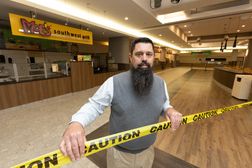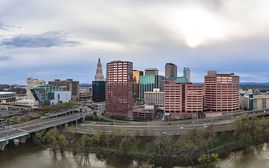Processing Your Payment
Please do not leave this page until complete. This can take a few moments.
-
News
-
Editions
-
- Lists
-
Viewpoints
-
HBJ Events
-
Event Info
- 2024 Economic Outlook Webinar Presented by: NBT Bank
- Best Places to Work in Connecticut 2024
- Top 25 Women In Business Awards 2024
- Connecticut's Family Business Awards 2024
- What's Your Story? A Small Business Giveaway 2024 Presented By: Torrington Savings Bank
- 40 Under Forty Awards 2024
- C-Suite and Lifetime Achievement Awards 2024
- Connecticut's Health Care Heroes Awards 2024
-
-
Business Calendar
-
Custom Content
- News
-
Editions
View Digital Editions
Biweekly Issues
- April 29, 2024
- April 15, 2024
- April 1, 2024
- March 18, 2024
- March 4, 2024
- February 19, 2024
- February 5, 2024
- January 22, 2024
- January 8, 2024
- + More
Special Editions
- Lists
- Viewpoints
-
HBJ Events
Event Info
- View all Events
- 2024 Economic Outlook Webinar Presented by: NBT Bank
- Best Places to Work in Connecticut 2024
- Top 25 Women In Business Awards 2024
- Connecticut's Family Business Awards 2024
- What's Your Story? A Small Business Giveaway 2024 Presented By: Torrington Savings Bank
- 40 Under Forty Awards 2024
- C-Suite and Lifetime Achievement Awards 2024
- Connecticut's Health Care Heroes Awards 2024
Award Honorees
- Business Calendar
- Custom Content
With 53 companies in recruitment pipeline, MetroHartford Alliance aims for big ‘wins’ in 2022
 David Griggs
David Griggs
David Griggs was hired as CEO of the MetroHartford Alliance in 2018 to be a disrupter.
And he’s been just that.
Since joining the organization, he’s implemented a new strategic direction: The Alliance, traditionally viewed as a regional chamber, has become more of a private economic development agency with a primary mission to lure jobs and talent to the region.
The restructuring included a new leadership team and beefing up recruiting strategies. The Alliance also spun out its chamber function, bringing back the old Hartford Chamber of Commerce name it hadn’t used for nearly two decades.
There was also a plan to kick-start an unprecedented level of travel to sell Greater Hartford across the country. However, the pandemic interfered with that, while also creating other challenges in the effort to recruit companies to the region.
But Griggs, who came to Hartford from Minneapolis where he was vice president of business investment and research at the Greater Minneapolis St. Paul Regional Economic Development Partnership, said he’s bullish on the region’s ability to attract investment in the year ahead.
He recently participated in a virtual Q&A with the Hartford Business Journal to talk about his accomplishments so far on the job, the Alliance’s current recruitment efforts and what will drive economic growth in Greater Hartford in the future.
Here’s what he had to say:
Q: Your time as MetroHartford Alliance CEO certainly got disrupted by the pandemic. What would you say are your major accomplishments so far?
Recreating the Hartford Chamber was an important milestone.
When I got to Hartford I met with investors, non investors, community leaders and just took it all in, and it really became clear that we needed to reconstitute the chamber to do chamber things, to focus on small businesses and get the chamber activities into the neighborhoods.
That’s why we rewrote our bylaws and reconstituted the chamber, named Julio Concepcion its executive director and gave it its own board.
They are doing things on behalf of the city’s small businesses. I’m excited about that.
Q: What have you done on the economic development front?
We helped create a Comprehensive Economic Development Strategy for our community, and in that plan we were audacious enough to say we wanted to grow our economy and population, which are things the Hartford region hadn’t done in a while.
(Specifically the plan outlined a five-year goal to increase the region’s population by 3% to 4%; grow GDP by at least 5%; and slash by one-third or more, Black and Hispanic poverty, unemployment and income disparities, compared to white and non-Hispanic residents.)
Here we sit two years into that plan and we are starting to grow (According to U.S. Census data, Hartford County’s population grew by about 1%, or 5,484 residents, over the past decade, although the city of Hartford lost 3% of its population during that time period).
We have learned to make a decent lemonade out of what the pandemic has given us. We are finding that the Great Resignation is really a reconfiguring of peoples’ priorities, and more people are finding that a place like Hartford really fits in well, that time with family matters, time to be outdoors matters, great schools matter, and that’s a lot of what we have to offer.
Q: What’s the Alliance’s overall economic development strategy right now?
We’ve put a lot of focus on Susan Winkler’s work through the CT Insurance and Financial Services (IFS) group, which is part of the MetroHartford Alliance and focuses on growing the insurance and financial services sector.
We have rightfully reclaimed the ‘insurance capital of the world’ title. We are actively promoting Hartford as the insurance capital and we will be announcing new partnerships with other countries in 2022.
We are forming unique partnerships with other countries around the world so they recognize Hartford as the place in the United States for insurance.
If we are going to be the insurance capital, the world needs to recognize that, and to do that we need to create these partnerships with other countries that are strong in insurance, like the United Kingdom and Germany.
In general, our economic development plan is to very aggressively go after the markets we are strong in: insurance, financial services, aerospace supply chain companies.
Q: Critics say the cost of doing business in Connecticut is an impediment to growth. What’s your view on that?
We did an effective tax rate study last year with accounting and consulting firm CohnReznick to compare the cost of doing business in Hartford to who we compete against in different sectors.
We are expanding that analysis because it was so eye opening. We are told all the time our taxes are too high. Look, if we can cut taxes I’m all for it. But when it comes to competing for new business we don’t have to compete against low-cost locations because we don’t really compete with them.
When we compete for an insurance company to expand or relocate, they aren’t looking at Fort Wayne, Indiana. I don’t have to be cost competitive with Fort Wayne. I need to be cost competitive with New York, Boston and other places where that company would consider locating.
And we are competitive. We are a cheaper option than those bigger cities.
Q: Is the goal to bring more big insurance carriers to Greater Hartford or insurance technology (insurtech) companies?
It’s all of the above. We have to help our incubator programs identify companies and bring them here and make them feel welcome here.
We also want to recruit the captive insurance industry. Connecticut continues to rank high for that industry to be located here.
We are very active in terms of putting Connecticut and Hartford in front of those types of companies by going to their conferences and meeting with their leaders.
As an economic development driver for Hartford, insurance has to be more than just our big businesses.
The challenge Hartford has had in the past is we haven’t generated our own disrupters. The disruption to the insurance industry has happened outside of Hartford and then we are left trying to catch up.
That’s why these insurance incubators and insurtech companies are so important for Hartford because it’s going to create the disrupters right here, so the insurance companies are paying attention to them and partnering with them so they get to own or manage the disruption to their industry.
Q: Pre-pandemic there was a major push for innovation and startups downtown, particularly around insurtech and medtech. A lot of that activity came to a halt during the pandemic. Will that activity come back and do you think insurtech is a realistic thing Hartford can be known for?
I think Hartford can absolutely be known for insurtech. When we think about our companies and what they need and where they are going, it doesn’t matter if it’s manufacturing, health care or insurance, having a workforce that is tech savvy is key.
When you look at the statistics, Hartford is now ranked in the top 25 in the country for new tech jobs. We are ranked in the top 15 for year-over-year growth in tech jobs, according to data from Burning Glass & CompTIA. The numbers pan out that we are becoming a tech hub.
The accelerators, in my mind, are absolutely vital. The economic resiliency of our community depends on our ability to not only retain our legacy companies but to grow new ones. The next Fortune 500 company in the Hartford region I hope will be a homegrown company.
As we start to invest in some of these startups a lot of them will fail. That’s OK. We need those accelerators to continue to churn out those new companies in hopes that for every 10 that get created, two or three actually stick.
Q: Are there other industries that offer growth potential for the region?
Health care is a huge opportunity for us. When you look at national rankings, Connecticut is always in the top for health care in the country.
When we are trying to attract talent, schools and health care are always top priorities, and that’s what we have here.
We find ourselves at an interesting crossroads where we have big insurance companies and great healthcare providers all within a relatively small region. We are looking at that convergence and trying to exploit that for the common good.
Q: So, what are you doing to recruit companies? What’s in your toolbox of strategies?
We have a new data center incentive that was passed by the state in the last year. We have been very active with going out there and meeting with data center site selectors.
We have an incentive here in Connecticut that can compete toe-to-toe with any incentive around the country.
We have worked with a developer to identify a way to get very cost competitive electricity, which is key for data centers since they consume a lot of energy.
We are not going to be cost competitive with Nebraska, but we don’t have to be. We have to be competitive with other Northeast locations to start to land data centers.
Q: What else are you doing in terms of your on-the-ground recruitment efforts?
It’s been a little difficult with the pandemic, but we are starting to do some face-to-face meetings again. But we’ve been doing virtual webinars with different site selectors.
We have a number of lead-generation firms and tactics that we use to try to promote Hartford as a place for doing business, just trying to get people to think about Hartford, and following up with as many virtual or in-person meetings as we can.
Q: What is your pipeline in terms of the companies you are trying to recruit to the region? What have been your biggest wins so far?
We’ve got 53 companies that are in some stage of conversation about potentially establishing a presence here.
I’m highly confident you are going to see a lot of great wins in 2022 when companies start to really pull the trigger on moves and investment. That’s been our challenge in 2020 and 2021, companies trying to understand what the post-pandemic world looks like for them.
Most office users have been consolidating down their footprints. We haven’t seen large expansions. What we have seen is small offices being created.
As companies downsize and people have left New York City they are setting up smaller offices to be closer to where their people now are. We are seeing some of that activity.
We are also seeing a lot of warehouse activity.
Home Depot’s new 421,000-square-foot distribution facility in South Windsor is a good example. We worked with the developer, Indiana-based Scannell Properties, to get that project landed, approved and built.
David Griggs
President & CEO
MetroHartford Alliance
Highest Education: Master’s degree in urban planning, University at Buffalo
Previous job: Vice President of Business Investment and Research, Greater Minneapolis St. Paul Regional Economic Development Partnership
Age: 55
Hartford sees growth in tech job postings
Greater Hartford in recent years has tried to build up its tech workforce, and has seen some wins with large, global IT companies like Infosys, HCL Technologies and Galax.solutions establishing presences in the Capital City. New data show that Greater Hartford has seen an increase in the past year in tech job postings. The data below compares metro Hartford tech job postings to other major regions.
|
Rank |
City |
Tech Jobs postings 3Q 2021 |
Tech Jobs postings 3Q 2020 |
% increase |
|
1 |
Dallas |
49,059 |
31,979 |
53.40% |
|
2 |
Chicago |
35,278 |
23,160 |
0.52% |
|
3 |
Atlanta |
30,444 |
21,111 |
44.20% |
|
4 |
Boston |
28,393 |
18,821 |
50.90% |
|
5 |
Seattle |
24,710 |
16,005 |
54.40% |
|
6 |
Austin |
19,355 |
13,433 |
44.10% |
|
7 |
Detroit |
16,263 |
9,351 |
73.90% |
|
8 |
Miami |
12,808 |
7,425 |
72.40% |
|
9 |
Tampa-St. Petersburg |
11,345 |
7,775 |
45.90% |
|
10 |
Portland |
8,699 |
5,657 |
53.80% |
|
11 |
Nashville |
7,552 |
5,236 |
44.20% |
|
12 |
Kansas City |
7,256 |
4,686 |
54.80% |
|
13 |
Indianapolis |
6,975 |
4,783 |
45.80% |
|
14 |
Salt Lake City |
6,486 |
3,368 |
95.60% |
|
15 |
Hartford |
5,896 |
4,019 |
46.70% |
Source: Burning Glass & CompTIA
Related Content

2022 Giving Guide
This special edition informs and connects businesses with nonprofit organizations that are aligned with what they care about. Each nonprofit profile provides a crisp snapshot of the organization’s mission, goals, area of service, giving and volunteer opportunities and board leadership.
Learn more
Subscribe
Hartford Business Journal provides the top coverage of news, trends, data, politics and personalities of the area’s business community. Get the news and information you need from the award-winning writers at HBJ. Don’t miss out - subscribe today.
Subscribe
2024 Book of Lists
Delivering Vital Marketplace Content and Context to Senior Decision Makers Throughout Greater Hartford and the State ... All Year Long!
Read Here-
2022 Giving Guide
This special edition informs and connects businesses with nonprofit organizations that are aligned with what they care about. Each nonprofit profile provides a crisp snapshot of the organization’s mission, goals, area of service, giving and volunteer opportunities and board leadership.
-
Subscribe
Hartford Business Journal provides the top coverage of news, trends, data, politics and personalities of the area’s business community. Get the news and information you need from the award-winning writers at HBJ. Don’t miss out - subscribe today.
-
2024 Book of Lists
Delivering Vital Marketplace Content and Context to Senior Decision Makers Throughout Greater Hartford and the State ... All Year Long!
ABOUT
ADVERTISE
NEW ENGLAND BUSINESS MEDIA SITES
No articles left
Get access now
In order to use this feature, we need some information from you. You can also login or register for a free account.
By clicking submit you are agreeing to our cookie usage and Privacy Policy
Already have an account? Login
Already have an account? Login
Want to create an account? Register
Get access now
In order to use this feature, we need some information from you. You can also login or register for a free account.
By clicking submit you are agreeing to our cookie usage and Privacy Policy
Already have an account? Login
Already have an account? Login
Want to create an account? Register









0 Comments